19th Century Distilling Papers at The Filson
By Michael R. Veach
Special Collections Assistant
About |
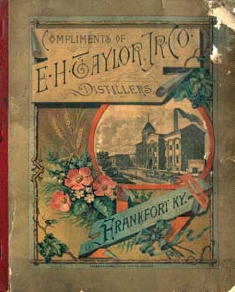 Many historians state that the 19th century starts with the French Revolution and ends with
the Great War. It can also be said that the 19th century distilling industry starts with the whiskey
rebellion and ends with prohibition, covering roughly the same time period.
Many historians state that the 19th century starts with the French Revolution and ends with
the Great War. It can also be said that the 19th century distilling industry starts with the whiskey
rebellion and ends with prohibition, covering roughly the same time period.
Since we looked at “Early Distilling Papers at The Filson” in a previous issue (Vol.5, No.3, Summer 2005), we will start here in the 1830s.
The distilling industry in the 1830s was beginning to shift from the farm to the city through “rectifiers” – merchants who bought whiskey from farmer distillers and “rectified” it to sell as their own brand. This process could be anything from simply aging the product to adding sugar and other flavoring agents to the alcohol to make a product more appealing to consumers. Most whiskey was sold by the barrel but many companies started bottling their product to sell to the consumer in the 1830s. The Filson has a scrapbook of labels produced by printer Henry Miller in the 1840s and 50s that include many labels for bourbon and rye.
The distillers in the first half
of the 19th century used pot still
technology and The Filson has a
Henry Clay legal brief that gives
a description of a typical pot still.
Clay is representing his cousin
Green Clay in a case against
George Coons and John Cock
for failure to deliver his still. The
invention of the column still in
1830 by Aeneas Coffey in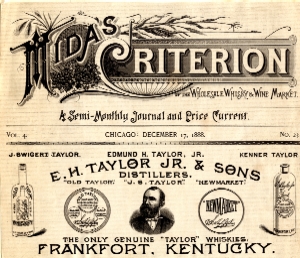 Ireland created a method
of distilling large amounts
of whiskey for a small
amount of money. This
allowed larger distilleries to
locate in cities and towns
with their supply of grain
coming to them by railroad.
It also allowed them
to produce higher proof
spirits that could be blended with
whiskey by rectifiers to create
cheap products.
Ireland created a method
of distilling large amounts
of whiskey for a small
amount of money. This
allowed larger distilleries to
locate in cities and towns
with their supply of grain
coming to them by railroad.
It also allowed them
to produce higher proof
spirits that could be blended with
whiskey by rectifiers to create
cheap products.
In the 1830’s James Crow became the distiller for Oscar Pepper at his Woodford County distillery. Crow started using scientific methods to measure such things as pH and temperature during the distillation process to document the process and its changes. The measurements made it easier to duplicate the process and make a consistent product. It was Crow’s quality of whiskey that E. H. Taylor, Jr. wished to produce when he entered the business after the Civil War. The Filson is fortunate to have records pertaining to E.H. Taylor, Jr. in the Taylor-Hay Family Papers.
Before entering the distilling business, Taylor took a tour of distilleries in Scotland, Ireland, Germany, and France to see for himself the most modern processes and distillery layouts. Upon his return to Kentucky his first project was helping with the design of the “Hermitage Distillery” for Gaines, Berry and Co. who owned the Old Crow brand at the time. A few years later he purchased an old distillery on the Kentucky River and rebuilt it as the “OFC Distillery” which started production in 1870. The Taylor-Hay Family Papers include Taylor’s correspondence from this period along with business receipts, letterpress books and distilling ledgers.
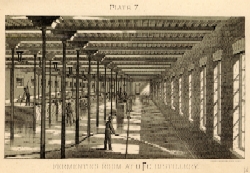 The “OFC Distillery” was an
“Old Fashioned Copper” distillery
that used pot stills and
small mash tubs to make a true
sour mash whiskey. Taylor was a
straight whiskey distiller and saw
the rectifiers as his main competition.
Taylor and others believed
that the rectifiers, who produced
an imitation bourbon using
neutral spirits and flavoring in
less than a day, were damaging
the tradition of quality aged
Kentucky whiskey. He was not
the only distiller who took this attitude.
Other distillers who agreed
with Taylor testified before Congress
and argued for the increase
of the Bonding Period for whiskey.
The Filson has his testimony
as recorded in the Congressional
Record for 27 July 1888 in the
library pamphlet collection. In
this pamphlet, distiller John
Atherton states that it is understood
in the industry that
Kentucky Whiskey is made for
the purpose of aging and most
often sold straight. He also goes
into detail on how the whiskey
is made and aged.
The “OFC Distillery” was an
“Old Fashioned Copper” distillery
that used pot stills and
small mash tubs to make a true
sour mash whiskey. Taylor was a
straight whiskey distiller and saw
the rectifiers as his main competition.
Taylor and others believed
that the rectifiers, who produced
an imitation bourbon using
neutral spirits and flavoring in
less than a day, were damaging
the tradition of quality aged
Kentucky whiskey. He was not
the only distiller who took this attitude.
Other distillers who agreed
with Taylor testified before Congress
and argued for the increase
of the Bonding Period for whiskey.
The Filson has his testimony
as recorded in the Congressional
Record for 27 July 1888 in the
library pamphlet collection. In
this pamphlet, distiller John
Atherton states that it is understood
in the industry that
Kentucky Whiskey is made for
the purpose of aging and most
often sold straight. He also goes
into detail on how the whiskey
is made and aged.
In the late 19th century most whiskey was sold by the barrel to a liquor store, druggist or tavern. The whiskey was then sold to consumers who would often bring in their own bottle or jug, but distilleries and rectifiers often offered jugs for sale to the consumer. The Filson has the J. D. Barnett Collection of stoneware jugs that are fine examples of typical 19th century whiskey jugs. Taverns would serve the whiskey to their customers by filling a bar decanter from the barrel when needed. Individuals could also purchase a full barrel and decant the whiskey as needed. The Filson Museum also has several nice examples of 19th century decanters.
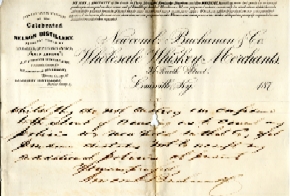 After the Civil War there were
many changes in the distilling
industry. In 1879 Fredrick Stitzel
patented the system of barrel
racks that is still used in bourbon
warehouses to store barrels today.
The Filson has his patent model
in its museum collection. In 1870,
George Garvin Brown
created the Old Forrester
brand of whiskey
and decided to sell it only
by the bottle in order to
guarantee the consistent
quality of the whiskey for
the medical trade. Brand
names became a very
important part of the industry
and advertising for
these brands began to appear.
The Filson has some
of this advertising art in its
museum collection including
an “I. W. Harper”
hunting scene on glass, an
“Old Dixie” oil painting
and a W. L. Weller “Mammoth
Cave” silk banner.
Letterheads are another source of
advertisement and The Filson has
several collections with examples
of distilling letterhead. The papers
for the 1895 Grand Army of the
Republic Encampment and the
Taylor-Hay Family Papers are
both rich with examples of
distillery letterhead.
After the Civil War there were
many changes in the distilling
industry. In 1879 Fredrick Stitzel
patented the system of barrel
racks that is still used in bourbon
warehouses to store barrels today.
The Filson has his patent model
in its museum collection. In 1870,
George Garvin Brown
created the Old Forrester
brand of whiskey
and decided to sell it only
by the bottle in order to
guarantee the consistent
quality of the whiskey for
the medical trade. Brand
names became a very
important part of the industry
and advertising for
these brands began to appear.
The Filson has some
of this advertising art in its
museum collection including
an “I. W. Harper”
hunting scene on glass, an
“Old Dixie” oil painting
and a W. L. Weller “Mammoth
Cave” silk banner.
Letterheads are another source of
advertisement and The Filson has
several collections with examples
of distilling letterhead. The papers
for the 1895 Grand Army of the
Republic Encampment and the
Taylor-Hay Family Papers are
both rich with examples of
distillery letterhead.
The library at The Filson is a
very good source for information
on 19th century distilling. Louisville
City Directories have ad-
dresses and often advertisements
for distillers and rectifiers. In the
Rare Books 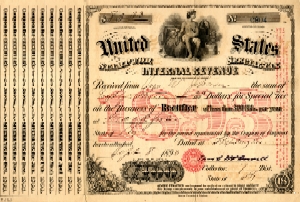 collection, there are
also several Louisville Business
Directories that give the location
of Louisville businesses including
distilleries and a brief description
and history of firms. These volumes
are indexed by firm names
and personal names. This index
was compiled by retired Filson
Librarian Dorothy Rush. Also
in the Rare Books collection is
a copy of the book A History of
Kentucky Distilling Interest published
by the Kentucky Distillers Bureau
of Lexington in 1893 that has
descriptions and brief histories
of distilling firms throughout
the state.
collection, there are
also several Louisville Business
Directories that give the location
of Louisville businesses including
distilleries and a brief description
and history of firms. These volumes
are indexed by firm names
and personal names. This index
was compiled by retired Filson
Librarian Dorothy Rush. Also
in the Rare Books collection is
a copy of the book A History of
Kentucky Distilling Interest published
by the Kentucky Distillers Bureau
of Lexington in 1893 that has
descriptions and brief histories
of distilling firms throughout
the state.
The end of the 19th century saw the passage of the Bottled-In- Bond Act of 1897. E.H. Taylor, Jr. played a significant role in getting this law passed and then promoting Bonded Whiskey in the U.S. market. “Bottled-In-Bond” whiskey must be all from the same distillery, made in the same season, aged at least four years, and bottled at 100 proof. At the time this law was seen as a model for future Pure Food and Drug laws. The Taylor-Hay Family Papers have three scrapbooks put together by E H Taylor, Jr. with many articles dealing with his efforts to promote Bonded Whiskey in the early 20th century.
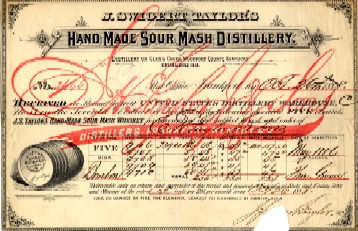 The distilling industry played an
important role in the 19th century
Kentucky economy. Kentucky had
hundreds of distilleries and rectifying
companies who provided
jobs and paid taxes, thereby helping
to support the government before
there was an income tax. The
20th century saw a huge change in
the business leading to the companies
and brands we know today.
The Filson has many sources
including both published materials
and original manuscripts, as well
as artifacts that are of interest to
anyone researching 19th century
distilling in Kentucky.
The distilling industry played an
important role in the 19th century
Kentucky economy. Kentucky had
hundreds of distilleries and rectifying
companies who provided
jobs and paid taxes, thereby helping
to support the government before
there was an income tax. The
20th century saw a huge change in
the business leading to the companies
and brands we know today.
The Filson has many sources
including both published materials
and original manuscripts, as well
as artifacts that are of interest to
anyone researching 19th century
distilling in Kentucky.
The Filson Historical Society
1310 South Third Street - Louisville, KY 40208
Phone: (502) 635-5083 Fax: (502) 635-5086
Hours
The Ferguson Mansion and Office
Monday - Friday: 9 am. - 5 pm.
Saturday and Sunday closed
Library
Monday - Friday: 9 am. - 5 pm.
Saturday: 9 am. - 12 noon
